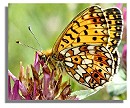
Graphics via Wikimedia
Butterflies of Scotland
- Small Heath (Coenonympha pamphilus)


This small (wingspan is 3cm / 1.2 inches), yellow-orange butterfly, has its hindwing banded with brown, grey and cream. The underside of the forewing has an eyespot at the tip. The Small Heath flies only in sunshine and rarely settles more than a metre above the ground. The butterfly loosely resembles a small Meadow Brown, but the brown colour of the wings appears noticeably paler in flight. Unlike the Meadow Brown and other common members of Satyrinae, the Small Heath only ever rests with its wings closed and angled at 90° to the sun.The Small Heath is widespread in Eurasia and north-western Africa, preferring drier habitats than other Coenonymphae. This relatively widespread butterfly can occupy a range of habitat types and, although its range has changed little, many colonies have disappeared in recent decades. The Small Heath, like its cousin the Wall Brown, has been in serious decline across much of southern UK. It is a UK Priority Species for conservation due to the continued loss of habitat and resulting drop in population. But numbers in Scotland are more stable and are not a conservation concern.
The larval host plants are grasses, notably Sheep's Fescue (Festuca spp.) meadow-grasses (Poa spp.), and bents (Agrostis spp.). The larvae have life spans of varying length, even within the same climate. The butterfly usually has two, occasionally three, broods (usually only one in Scotland) and is on the wing in the UK from mid May until early October (late June to mid August in colder climates such as Scotland) but numbers peak throughout the UK in July and August. The butterflies live for about a month. The insect overwinters in its larval stage and forms a chrysalis in early spring.
The Small Heath can be found mainly on grassland where there are fine grasses especially in dry well-drained situations where the sward is short and sparse. The largest colonies occur on downland, heathland, and coastal dunes. Smaller populations occur in many other locations including roadside verges, waste ground, woodland rides and glades, moorland, and parkland.
Return to the Butterfly Index
or go to the next Butterfly:  Small Pearl-bordered Fritillary.
Small Pearl-bordered Fritillary.
Where else would you like to go in Scotland?

